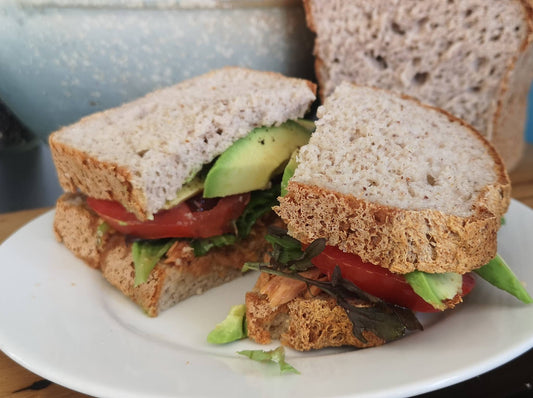-
GF Fruit Bread Mix
Vendor:2 LOAVESRegular price $16.00 NZDRegular priceUnit price / per -
GF Lightly Seeded Bread Mix
Vendor:2 LOAVESRegular price $18.00 NZDRegular priceUnit price / per -
GF Soft Brown Bread Mix
Vendor:2 LOAVESRegular price $16.00 NZDRegular priceUnit price / per -
GF Magic Muffin Mix
Vendor:24 MUFFINSRegular price $16.00 NZDRegular priceUnit price / per -
Starter Kit
Vendor:Gluten Free Baking BlendsRegular price $40.00 NZDRegular priceUnit price / per -
Beeswax Bread Wrap
Vendor:Gluten Free Baking BlendsRegular price $16.00 NZDRegular priceUnit price / per
FAQ
Should I buy the single mixes or the 2kg bags?
The single loaf mixes have been designed for a 1kg tin available for purchase from us separately, or as part of the starter package. We decided on a smaller loaf size as gf bread without preservatives, is best eaten fresh or within a couple of days of making, meaning it is better to make a smaller loaf more often, than throwing away leftovers of a larger loaf made less frequently. But if you have your own good bread tin, you may prefer to buy the 2kg bags and work out the quantity of mix accordingly.
What type of yeast should I use?
Yeast is a fungus that grows in nature so by itself it is gluten free. Yeasts that you buy in the supermarket need to be chosen carefully. Choose a pure variety, not an “active yeast mixture” which has other ingredients added, including wheat.
Good choices: Edmonds Active Yeast, Tasti Active Dried Yeast, Pam’s Active Yeast, Bakels Active Dried Yeast. BE SURE TO CHECK USE-BY DATE ALSO
What temp should my water be?
east likes warm conditions to grow and multiply. The optimum temperature range is around 27oC. This is the temperature the batter should be when set in the tin to rise. The temperature of the water you add should be about achieving this temperature in the batter. Too hot and it will kill the yeast, too cold and the batter will take an age to rise. I use water that is the same temperature I would have if I were having a bath. Obviously other factors need to be considered. If your ingredients and/or the room temperature are cold, then slightly warmer water should be used. Similarly, on a hot day, with warm ingredients, you can get away with a slightly cooler water temperature. The water should never be less than bath temperature however. Experience will teach you. If using a breadmaker, follow their instructions.
What is the best way to measure my water?
The water quantity is crucial to the success of your bread. We recommend electronic scales, as these can accurately measure both the dry mix and the water. It is important to remember that 1 ml of water = 1 g. So, 400ml of water is the same as 400g on the scale.
Why won’t my bread rise?
There are many reasons why your bread won’t rise. Here are the main ones:
You forgot to add the yeast – sounds stupid but can easily happen.
Your yeast was out of date. Yeast does have an expiry date which you should check before using. If in doubt, put a little yeast in some warm water with ½ teaspoon of sugar and wait to see if a froth forms on the surface. No froth within a few minutes is an indication your yeast is not fresh
Your water was too warm and it killed the yeast. If you cannot hold













